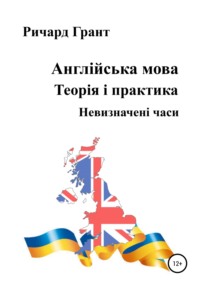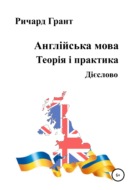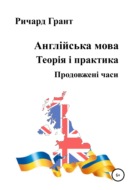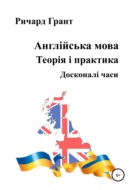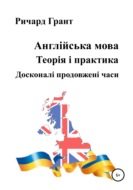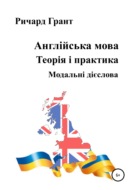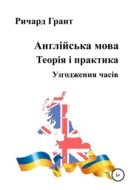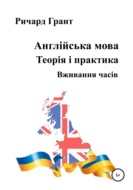Buch lesen: "Англійська мова. Теорія і практика. Невизначені часи"
Невизначені часи вживаються для вираженийня дій або станів в сьогоденні, минулому або майбутньому, не вказуючи при цьому на характер протікання дії (тривалість, завершеність, передування по відношенню до іншої дії).
Простий теперішній час – The Present Simple Tense
Present Simple Tense – простий теперішній час, описує дію в широкому сенсі слова. Використовуючи цей час, люди розповідають про свої звички і про інші регулярні дії і речі, які завжди правдиві, тобто цей час позначає дію, яка відбувається зазвичай, регулярно.
З цим часом часто вживаються прислівники невизначеного часу: usually – зазвичай, sometimes – іноді, seldom – рідко, always – завжди які, як правило, стоять перед смисловим дієсловом), а також словосполучення типу every day – кожен день, every morning – щоранку та iншi, on Sundays – по неділях та iншi, twice a week – два рази на тиждень та iншi
Утворювання Present Simple Tense для всіх дієслів, крім to be:
Розмовне речення – Subject + verb + …
We live in a huge industrial city. – Ми живемо у величезному промисловому місті.
Заперечне речення – Subject + do/does + not + verb + …
Joanne doesn't spend much time on the Internet. – Джоан не проводить багато часу в Інтернеті.
Питальне речення – (Question word) + do/does + subject + verb + …?
Do you often get together with your relatives? – Ви часто зустрічаєтеся з родичами?
Do – допоміжне дієслово – використовується з підметом, вираженим іменником у множині або займенниками I, you, we, they.
Does – допоміжне дієслово – використовується з підметом, вираженим іменником в однині або займенниками he, she, it.
Do i does не перекладаються, а лише вказують на заперечну або питальну форму.
У розмовній мові, в заперечій формі часто використовуються скорочення don't/doesn't замість do not/does not.
Підмет – subject – може бути виражений будь-яким іменником або займенниками I, you, we, they, he, she, it.
Присудок – verb – може бути виражений будь – яким дієсловом.
Якщо підмет – subject – виражений займенниками he, she, it або іменником в однині, то в стверджувальній формі до присудка – verb – додається закінчення -s або -es.
Якщо підмет – subject – виражений займенниками I, you, we, they або іменником у множині, то в стверджувальній формі присудок – verb – не змінюється.
Питальна форма може будуватися як зі спеціальним питальним словом – question word, яке ставиться на початку речення, так і без нього.
Короткі відповіді
При відповіді на питання, що передбачає відповідь так чи ні, використовуються наступні шаблони:
Do you study English? – Yes, I do. – (позитивна відповідь) – No, I don't. – (негативна відповідь)
Do you study English? – Yes, we do. – (позитивна відповідь) – No, we don't. – (негативна відповідь)
Do they study English? – Yes, they do. – (позитивна відповідь) – No, they don't. – (негативна відповідь)
Does he study English? – Yes, he does. – (позитивна відповідь) – No, he doesn't. – (негативна відповідь)
Утворювання Present Simple Tense для дієслова to be:
Розмовне речення – Subject + to be (am/is/are) + …
I am at work. – Я на роботі.
Заперечне речення – Subject + to be (am/is/are) + not + …
He isn't an engineer. – Він не інженер.
Питальне речення – (Question word) + to be (am/is/are) + subject + …?
Are you curious? – Ти цікавий?
Дієслово to be змінюється по особах і числах:
I – am
He, she, it – is
You, we, they – are
У розмовній мові,
у ствердній формі часто використовуються скорочення I'm/you're … it's замість I am/you are … it is
у заперечнiй формi – I’m not/you aren't … it isn't замість I am not/you are not … it is not.
Короткі відповіді
При відповіді на питання, що передбачає відповідь так чи ні, використовуються наступні шаблони:
Are you a doctor? – Yes, I am. – (позитивна відповідь) – No, I am not. – (негативна відповідь)
Is she a doctor? – Yes, she is. – (позитивна відповідь) – No, she isn’t. – (негативна відповідь)
Are they doctors? – Yes, they are. – (позитивна відповідь) – No, they aren’t. – (негативна відповідь)
Якщо в питальному реченні зі спеціальними питальними словами Who (в значенні хто) або What відсутній підмет, що відповідає на питання хто? або що?, то допоміжне дієслово do/does не вживається, а використовується основне дієслово із закінченням -s, (-es) без частинки to.
What/Who + verb + (-s, -es) + …?
What attracts him there? – Що його там приваблює?
Verb + to + verb – два дієслова, якi йдуть один за одним, поділяються часткою to.
I want to know it. – Я хочу це знати.
Вправа 1
Вставте дієслово to be в Present Simple.
1. What … your name? – My name … Shirley Frank. 2. … your sister a typist? – No, she … not a typist, she … a student. 3. Where … you? – I … in the kitchen. 4. Where … the keys? – In your jacket. 5. What … your address? – My address … 175 Grand Central Parkway. 6. … your brother at school? – Yes, he …. 7. Art … long, life … short. 8. Where … Fred? – He … in the garage. 9. What … the time, please? – It is two o’clock. 10. You … the best friend I have ever had. 11. What … your phone number? – My phone number … 718-1930. 12. … your sister at school? – No, she … not at school. 13. Where … Lisa and John? – They … at college. 14. It … the biggest meal I have ever had. 15. I don’t remember what his telephone number … .
Вправа 2
Вставте дієслово to be в Present Simple.
1. Where … you from? – I … from New York. 2. My sister … at home. 3. … you busy? – No, I … not. Mike … busy. He … the busiest person I have ever met. 4. Which sport do you think … the most dangerous? 5. Two heads … better than one. 6. I … a pupil. 7. … this your watch? – Yes, it … . 8. It … ten o’clock. She … late again. 9. Chess and aerobics … not as exciting as skydiving and figure skating. 10. You … right. That … a lot of money! Coffee … really very expensive this week. 11. My father … not a teacher, he … a scientist. 12. She … an actress. 13. How … you? – I … not very well today. – I … sorry to hear that. 14. Debt … the worst kind of poverty. 15. … your aunt a doctor? – Yes, she … .
Вправа 3
Вставте дієслово to be в Present Simple.
1. This … my bag. 2. We … interested in classical music. 3. The game … not worth the candle. 4. … they at home? – No, they … not at home, they … at work. 5. My uncle … an office worker. 6. Vera … afraid of snakes. 7. Do you have any idea where he …? 8. My brother … a worker. He … at work. 9. He … at work. 10. My grandmother … not nervous and she … rarely upset. She … the kindest person I’ve ever seen. My grandmother … really wonderful. 11. Used cars … cheaper but less reliable than new cars. 12. … you an engineer? – No, I … not. I … a lawyer. 13. Helen … a painter. She has some fine pictures. They … on the walls. She has so much paper. It … on the shelf. The shelf … brown. It … on the wall. Helen has a brother. He … a student. He has a family. His wife … not from Toronto, she … from Montreal. They … nice people. 14. I … sorry. They … not at the office at the moment. 15. What … the weather forecast for tomorrow?
Вправа 4
Перекладіть на англійську мову, вживаючи дієслово to be в Present Simple.
1. Як тебе звати? – Мене звати Аня. 2. Він студент. 3. Мій дідусь вчений. 4. Мене звуть Катя. 5. Чия це ручка? – Це моя ручка. 6. Де твоя мама? – Вона на роботі. 7. Яка твоя адреса? – Моя адреса: Оксфорд Стріт, 45. 8. Ви студент? – Ні, я лікар. 9. Моя мама не вчителька. Вона лікар. Вона дуже добрий лікар. 10. Мені 14 років. 11. Чия це книга? – Це ваша книга. 12. Де твій брат? – Він в школі. 13. Звідки ти родом? – Я з Лондона. 14. Моя сестра у будинку. 15. Я канадець. Я з Торонто. 16. Чий це стіл? – Це стіл мого брата.
Вправа 5
Перекладіть на англійську мову, вживаючи дієслово to be в Present Simple.
1. Де твоя сестра? – Вона вдома. 2. Хто цей чоловік на фотографії? – Це мій батько. 3. Ми не в школі. Ми вдома. 4. Я учениця. 5. Чия це сумка? – Це сумка моєї мами. 6. Чий це олівець? – Це мій олівець. – А де мій олівець? – Він на столі. 7. Як його звуть? – Його звуть Джон. 8.Мой брат учень. Він в школі. 9. Мій улюблений вид спорту – теніс. 10. Чий це олівець? – Це олівець моєї сестри. 11. Чий це годинник? – Це мій годинник. – А де мій годинник? – Вiн на столі. 12. Де він? – Він в Лондоні. 13. Ваша мама вдома? – Нi, вона на роботі. 14. Це твiй зошит? – Так. 15. Де твій ноутбук? – Він у кабінеті на письмовому столі. 16. Я Олена, а це Коля. Він мій брат. Йому 10 років, а мені 12 років. Ми з Торонто
Вправа 6
Перекладіть на англійську мову, вживаючи дієслово to be в Present Simple.
1. Ваш двоюрідний брат вдома? – Ні він в школі. Він учень. 2. Мій улюблений предмет – англійська мова. 3. Це зошит твого брата? – Ні, це мій зошит. 4. Я учень. Я в школі. 5. Ваша сестра вчителька? – Ні, вона студентка. 6. Мій тато програміст. Він не цікавиться політикою. Його улюблені види спорту – футбол і плавання. 7. Де ваш стіл? – Він посередині кімнати. 8. Мій брат художник. Він не інженер. 9. Твій тато на роботі? – Ні, він вдома. 10. Моя мама зубний лікар. Вона цікавиться мистецтвом. 11. Де твоя ручка? – Вона в моїй кишені. 12. Моя сестра на роботі. Вона лікар. 13. Твоя сестра друкарка? – Так. – Вона вдома? – Нi, вона на роботі. 14. Ми завжди зайняті, але ми дуже щасливі бути разом. 15. Де твiй зошит? – Вiн на столі. 16. Я цікавлюся музикою.
Запам'ятайте:
Дієслово to have змінюється по особах і числах:
I, you, we, they – have
He, she, it – has
Вправа 7
Розкрийте дужки, вживаючи дієслова в Present Simple.
1. My working day (to begin) at seven o’clock. I (to get) up, (to switch) on the radio and (to do) my morning exercises. It (to take) me fifteen minutes. At half past seven we (to have) breakfast. My father and I (to leave) home at eight o’clock. He (to take) a bus to his factory. My mother (to be) a doctor, she (to leave) home at nine o’clock. In the evening we (to gather) in the living room. We (to watch) TV and (to talk). 2. Andrea Schatzmann, an exchange student from Switzerland, (to live) with the Connor family in San Francisco. She (to get) up at 7 am and (to take) a shower. She normally (not to have) breakfast. At half past seven she (to catch) the bus. Her first class (to start) at a quarter past eight. She always (to have) lunch at 12 o’clock in the cafeteria. The cafeteria food (to be) OK and it (to be) cheap too. Her afternoon classes (to be) from 1.15 till 3.00 pm, so she (to be) at school all day. She usually (to have) dinner with the Connors at about 8.00. On Saturdays she (to have) lunch at the restaurant. Once a week, usually on Sunday mornings, she (to go) swimming. A few friends usually (to go) along, too. One of her friends has got a car, so he (to pick) them up and then he (to drive) them home. After swimming they often (to go) out for a pizza. On Saturday evenings she sometimes (to go) out with friends to a party or maybe to a concert. Sometimes she (to invite) friends to her house and they (to listen) to music and (to talk). Mr. and Mrs. Connor often (to take) them for a camping weekend to the seaside or to the mountains. From time to time she (to call) her family in Switzerland. They never (to talk) for very long because it (to be) expensive. She usually (to call) on Sundays because it (to be) cheaper then. 3. My sister (to get) up at eight o’clock. 4. What time Andrea usually (to get) up? 5. She (to be) a schoolgirl. She (to go) to school in the afternoon. 6. When she (to catch) the bus? 7. Jane (to be) fond of sports. She (to do) her morning exercises every day. 8. She (to take) a shower in the morning? 9. For breakfast she (to have) two eggs, a sandwich and a cup of tea. 10. She (to go) home for lunch? 11. After breakfast she (to go) to school. 12. When she (to go) swimming? 13. It (to take) her two hours to do her homework. 14. How she (to get) to the pool? 15. She (to speak) French well. 16. What she (to do) on Saturday evenings?
Die kostenlose Leseprobe ist beendet.
